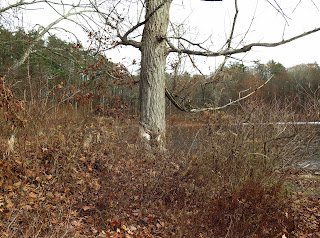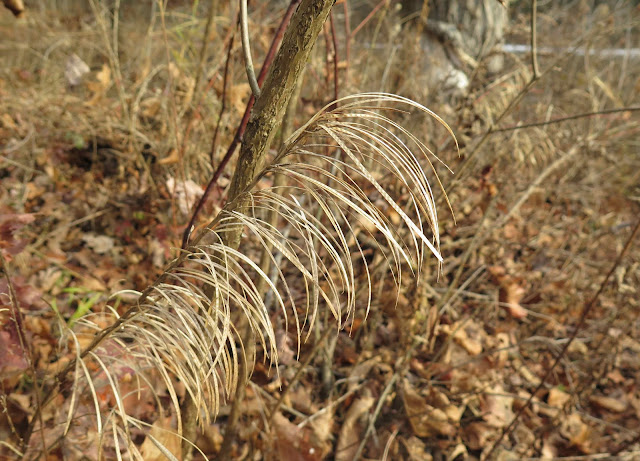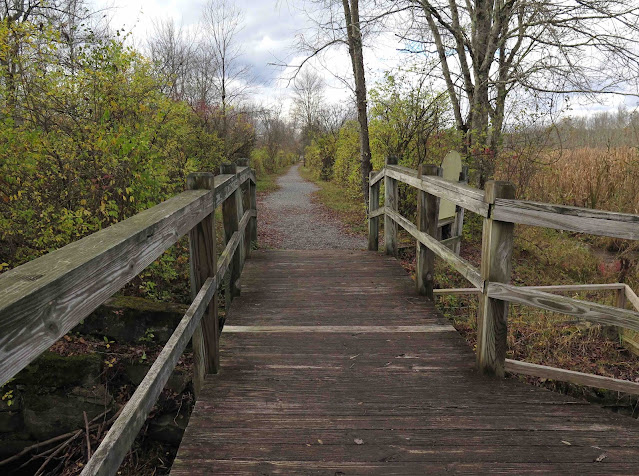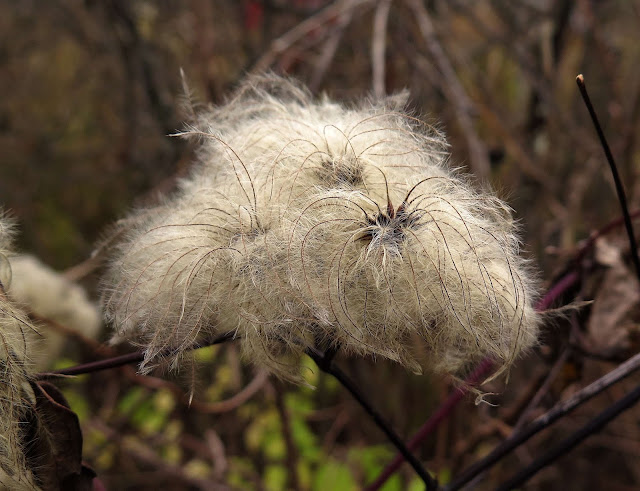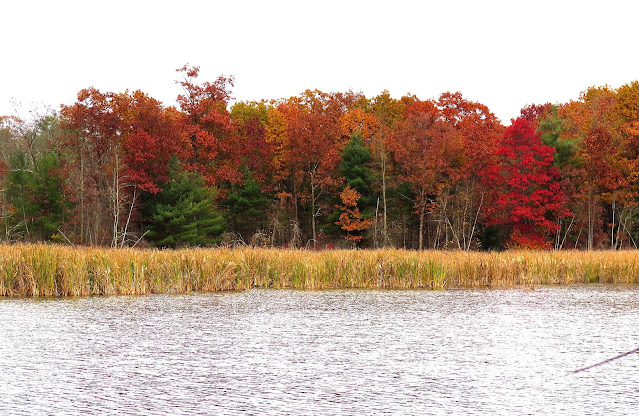I am one of those odd folks who actually loves November -- this brown and bronze season as our warm-weather plants settle down for their long restorative winter naps. But darn it all, old age has imposed on me a painful eye condition called Ocular Rosacea that is triggered by cold weather. It makes my eyes feel as if there were grit beneath my eyelids as inflammation causes the lower lashes to turn inward and poke at my eyeballs. That stings! And spending hours looking at a computer screen exacerbates the condition. I have managed to keep going outdoors, even on frosty days, but the work of editing photos and writing blogs has been a painful chore I have been avoiding. I did, though, manage to choose a few photos from several recent outings that I want to post here. I do like to keep this blog going, even if just for myself, since it serves me as a phenological record of what happens when, in my natural surroundings. By New Year's Day, 2024, my blog will consist of 15 years of botanical explorations of this northeastern part of New York State.
First Frost at Mud Pond
I don't know if November 2 is an especially late date for first hard frost in northern Saratoga County, but I do know that my friend Sue Pierce and I had been waiting and waiting what seemed a long time for it this year. And this was our lucky day. First Frost is a day we wildflower nerds celebrate as the day to go Frostweed hunting. And the sandy-soiled powerline easement just north of Mud Pond at Moreau Lake State Park is the place we know we will find it.

But it can't be just any old First Frost morning. The night must be clear for optimum radiational cooling of the land, cold enough for the fluid in the stems of the Frostweed (Crocanthemum canadense) to freeze and expand and split the stems of this native wildflower, and it has to be a night and a morning without a breath of wind that would quickly dissipate the emerging vaporous fluid as it curls around the stems. Sometimes those curls look as frothy as clouds, while today they appeared like fine threads of ice spooling around the stems.
The frost also spangled all the plants that grow in the open area below the power lines. These British Soldier lichens (Cladonia cristatella) added a dash of brilliant red among the ice crystals.
The Clubmoss called Running Pine or Wolf's Claw (Lycopodium clavatum) looked as if it had sprouted white fur all over instead of just at the tips of its branches.
These small taupe-colored mushrooms looked quite silvery amid this frosted patch of Juniper Haircap Moss (Polytrichum juniperinum).
Sadly, my photo of these deep-pink tufts of Small Red Sphagnum moss (Sphagnum capillifolium) could not display how twinkly they sparkled as the sun touched the crystals of frost.

As the frost dissipated when the morning sun's warmth reached the powerline, Sue and I continued our walk on the forested trail around Mud Pond.
We always search for the evergreen basal leaves of two orchids that thrive in the pine-needle carpeted woods that surround Mud Pond. We did find many pale-green basal rosettes of Checkered Rattlesnake Plantain (Goodyera tesselata).
But we found only one small patch of Downy Rattlesnake Plantain (G. pubescens), its darker-green leaves distinctively marked by a very pale central vein.
What a charming find this was, these itty-bitty orange mushrooms sprouting up from within a lush green patch of Atrichum moss.
This, too, was a charming find, the tiny ear-shaped fruiting bodies of a fungus much more frequently seen as a blue-green stain on rotting hardwoods. Chlorociboria is the genus, while whether its species is aeruginosa or aeruginascens can only be determined by microscopic examination of its ascospores. The two look very much alike, both displaying this vivid teal color so remarkable to see in a mushroom.
As the trail that circles the pond reconnects with the powerline, there is a patch of brilliant red-berried American Climbing Bittersweet (Celastrus scandens) sprawling in the grass.
This native species of bittersweet can be distinguished from the highly invasive Asian Bittersweet (C. orbiculatus) by the way its berries are borne in terminal clusters at the ends of its stems. The berries of the Asian import are borne in the leaf axils along the vines. The leaves look quite different, too, with those of our native species being longer and narrower, with sharply pointed teeth, while those of the Asian species are nearly round with blunt teeth. Our native bittersweet is quite a rare find these days, as it has been seriously supplanted or hybridized by the invasive non-native species. I feel quite fortunate to know where this patch of it can be found.
Heading home to Saratoga Springs by driving over Mount McGregor, I was struck by the brilliant and beautiful abundance of fruit on the Winterberry shrubs (Ilex verticillata) this year. Especially in this little swamp that borders the Wilton Mountain Road
Roadside Rocks and a Waterfall Climb
Last May, I was truly dismayed while driving along Spier Falls Road where the road closely follows the Hudson River at Moreau, and steep cliffs of the Palmertown Mountains rise from the side of the road. These cliffs hold many ledges where a marvelous mix of native mosses and wildflowers grow, constantly watered in every season by springs that drip down the face of the cliffs. But back then, a roadwork crew had scraped all vegetation from these roadside cliffs and ledges. Wondering what those rocks would look like today, I returned to the site late last week.
As I approached, the rocks still looked very bare, the stone still bearing the scars of being scraped clear of vegetation.
But as I drew closer, I could detect patches of green stuff reclaiming these rocks as their home, and the evergreen pink-edged basal rosettes of Early Saxifrage (Micranthes virginiensis) had reasserted their place among the marvelous mix of spring-dampened mosses. Here's hoping masses of their tiny white flowers will once again transform these bare rocks to spectacular rock gardens next spring.
Nearby, I could hear the music of water splashing from rock to rock, and I was delighted to find this long waterfall plunging its precipitous white-water way down the mountainside. It beckoned me to ascend its course, up and up and up, to explore some wide meadows along a high powerline road.
The wet banks of the waterfall are home to many different mosses, including this sprightly patch of a Sphagnum species. Many other lovely mosses covered the waterside rocks, but, being alone, I did not want to risk a fall by venturing out on such slippery surfaces to examine those mosses more closely.
As I emerged from the forested mountainside to the wide meadows along the powerline, I was happy to find that many tall clumps of Switchgrass (Panicum virgatum) had retained their vivid yellow color this late in the season. Although this perennial bunchgrass is native to most of North America east of the Rockies, I have rarely found it growing wild around here, except in areas of grassland restoration. Or in ornamental plantings. And also along this high mountainside powerline.
Old Friends, New Finds in Cole's Woods
This past Thursday promised to be sunny and pleasant for our friends in The Thursday Naturalists to walk in Cole's Woods, a many-acred forest right in the center of Glens Falls. But lucky for us, it was still a bit below freezing when we first arrived. That meant we were treated to an extensive patch of Frostweed doing its frosty thing down in the tall grass.
Even though the Frostweed (Crocanthemum canadense) was surrounded by tall stands of Little Bluestem Grass, its frothy stark-white curls were immediately visible to our searching eyes. By the time we passed this sun-warmed patch again on our way home, there wasn't a wisp of these icy curls left.
Cole's Woods is home to many interesting native plants, many of which we would not be able to locate, even as remnants, this time of year. But Green Rock Cress (Borodinia missouriensis) is probably at its most visible now, with its long arching pale-colored seedpods standing tall and wafting in the breeze. This native Mustard-family plant is actually rated as a Threatened species in New York State, and as Rare to Extremely Rare in New England states as well. But you'd never guess it was such a rare plant from the large population that grows right here in Cole's Woods.
One of our destinations today was an old rotting tree trunk we had visited on a previous walk in this woods. Back then, we had found many different species of fungi residing on this trunk, but this time we found just the two different species of Eyelash Cups, the larger (but still quite small) deep-orange ones called
Scutellinia scutellata and also the teeny-tiny yellow ones,
Scutellinia setosa. Both species occupied this knot on the trunk.
Here's a whole bunch of the itty-bitty Scutellinia setosa scattered across the rotting wood.
When I first passed this stand of Spotted Alder and noticed a colony of Woolly Alder Aphids occupying a twig, I hardly slowed my pace, since I often find these bunches of woolly-looking all-female wingless clones this time of year. And this population appeared to be nearing the end of its seasonal stay, since it appeared that many had already died and dropped off, having cloned a final population of winged aphids that flew away.
But wait a minute! What the heck are those black spongy blobs attached to the alder twigs right below where the aphids had been feeding! I had read about how a black mold often grows on the honeydew secretions the aphids produce. Could this be that? But I thought that that mold was a flat sticky stuff. These growths were puffy and soft, not sticky at all.
When I pulled a blob off and examined it closely, its greenish thready interior looked more like one of those bearded lichens that grow on tree limbs. But those lichens tended to be dry and crispy. This stuff was soft and spongy.
Well, thanks to our dear fellow-naturalist friend Tom Callaghan and his cell-phone access to iNaturalist, we promptly obtained an accurate ID of this stuff: the Honeydew Eater Fungus (Scorias spongiosa), a sooty mold fungus that grows on aphid honeydew, but only on the honeydew produced by aphids that feed either on beech or alder trees. (Luckily, these were Woolly Alder Aphids, not the Woolly Beech Aphids, which create disease on beech trees. The aphids who feed on alders do not harm their host.)
This was certainly a first find for me. I have been observing Woolly Alder Aphids for at least 10 years and never found this spongy stuff in connection to them. And believe it or not, I found a U.S. government medical site on Google that claims that Scorias spongiosa is not only edible, but it also has multiple anti-inflammatory and antioxidant medical benefits. But please don't take my word for that.


